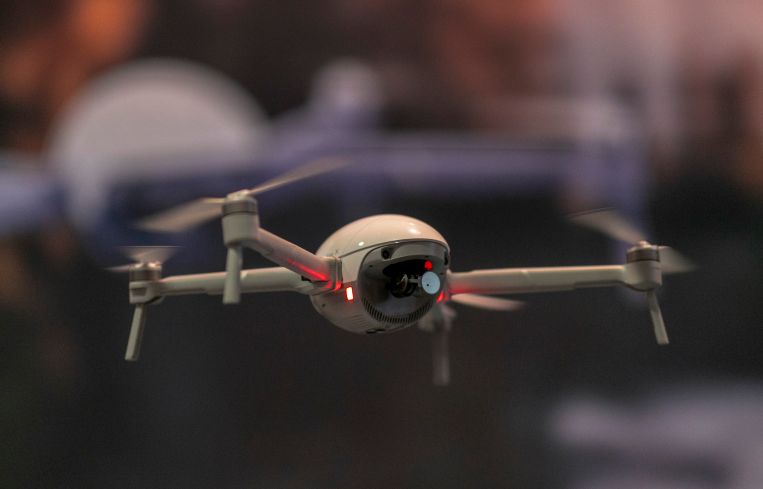Drone Pilots for Real Estate Projects in Greater Demand
Can supply for certified ‘droneographers’ keep up? And, in the meantime, here comes Robot Dog.
By Philip Russo March 1, 2022 10:00 am
reprints
“I got a guy,” is one way to say, “I know someone who can get the job done.” These days, such an expression applies more specifically when it comes to photographing and videoing real estate, as a greater number of industry developers and owners are saying, “I got a drone guy.”
The archaic gender specificity of such generic phrases aside, certified drone pilots are increasingly in demand for real estate projects of all kinds, and, according to some in the industry, there are not enough of them to meet the demand.
Two reasons for the drone pilot shortage are government regulations and compensation, said Bobby Quinn, CEO and co-founder of Tampa, Fla.-based Paypixl. He described his company as an online “marketplace that allows anybody to find a drone pilot and order the imagery they need when and where they’re needed across the country, even if you want to find a pilot in another state.”
As to government regulations, drone pilots that want to get paid for their services are supposed to have a Part 107 certification from the Federal Aviation Administration. “In the U.S. right now there are about 2.5 million recreational drone pilots and they are not Part 107-certified,” said Quinn. “There are about 250,000 who are Part 107-certified, or just under or over 10 percent.”
A pilot, veteran aerial photographer and a certified Part 107 drone operator himself, Quinn founded Paypixl in 2019 to bring drone pilots and companies wanting to employ them together on one software as a service, or SaaS, platform.
Drone pilots are “part-time workers, more than not,” Quinn said. “They’re using their drones to make money as a small business. The two major problems they have are finding new customers and getting paid quickly. We’re building a software that helps them with that component. They can upload their portfolio and profiles, and share them easily with a single link.
“We’re allowing them to build their companies [while] pulling their customer information and populating our business intelligence with who is actually [doing] what and where. On the flip side, we’re allowing people to query for these pilots in our network.”
Quinn hopes that such a platform will enable more recreational drone operators to make the leap to becoming professionally certified pilots.
Demand for drone pilots is growing, as Paypixl tripled its user growth in the last two weeks and has more than 300 users, Quinn said. “We’re hoping to track 7,000 users in the next 12 months.”
He added that having already raised $300,000 from friends and family, on Feb. 25 the company started its “first institutional round,” looking to raise $1.2 million. “We hope to close that over the next six weeks.”
As for compensation issues, while there is no set industry standard for drone pilot payment, drone-created real estate photos “run about $100 to $150 a day for a property,” said Quinn, while “ground-based imagery for real estate mixed with aerial [photography] is usually right around $250 to $350. With video, you generally add anywhere between $500 to $1,500.”

For Colin Behring, CEO of Behring Companies, a Danville, Calif.-based, mixed-use real estate development and private equity platform, drone pilots have become so integral to his business that he has one on staff as part of his marketing department.
“We have a huge appreciation of what drones have done to change the ability to get really good photography at an economical price,” Behring said. “Before, if you had to hire a helicopter or an airplane, it was just a daunting task that’s super expensive and hard to achieve. A drone just makes really good, Hollywood-quality, cinematic footage [that is] accessible to a lot more people than it used to be.”
Piloted drones have been used to shoot real estate exteriors and interiors for years, but while the technology has improved, a pilot can command from a few hundred dollars a project to six figures, depending on their skill level, Behring said.
“The most successful, financially impressive drone pilot that I know is somebody that actually races drones,” he said. “That person was hired freelance to do auto commercials in Italy, chasing [and shooting] Ferraris. It was for big-time advertising. He gets flown across the world to shoot for a week and gets paid a lot of money, like in the six-figure range, to go do that.”
Obviously, real estate drone pilots aren’t able to make that kind of money, but they do have unique talents, said Paypixl’s Quinn.
“We have drone pilots who are also photographers, videographers and cinematographers,” Quinn said. “I call them droneographers. The majority of the commercial drone pilots out there are already photographers and videographers. They’re just adding another camera to their bag, if you will. The majority of them are also ground-based photographers and videographers.”
However, at least for on-the ground interior shoots, piloted drones may already be feeling Massachusetts Institute of Technology’s Robot Dog nibbling at their profitability, Behring said.
“If you are inside a building, trying to get vantage points of eye height, or some sort of movement, you’re not doing it by hand with a harness camera,” he said. “You’re trying to save money on that aspect and have the drone just fly the floors. But you’re going to have competition with things like the MIT Robot Dog that goes walking through buildings and can do the same aerial photography and things like that. It’s robotic, automated and guided by GPS.”
Philip Russo can be reached at prusso@commercialobserver.com


